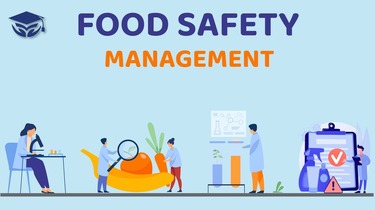
What is a Food Safety Management System?
Over time, the developments of basic dependencies have made a human civilization’s process of striving a bit more convenient. Yet with convenience comes a slight scope of loopholes in that certainly developed system. Food safety management consists of systems that rely on efficient manufacturing and production of edible products consisting of valuable nutritional value in prominent quantities.
The scale of food safety management could differ, yet the parameters of nutritional value and quantity fluctuate. Food safety is one of the crucial elements of welfare as it would eliminate phenomena like hunger or starvation.
The food safety management system reflects a framework that would focus on monitoring and managing an efficient working system for the food safety industries. Under this process, the stages are from gathering raw materials to the final stage of distribution and consumption.
With the FSMA, the task is to look into the system of management and intervene whenever the loopholes bother the fluent functioning of the system. Loopholes, in certain cases, could be identified as some chemical, physical or microbiological hazard that would affect the quality of the product. The system ponders on the issues that would affect the consumption or nutritional intake quality of a group of people in any targeted area.
FSMA ensures the execution of ideal manufacturing practices, hygiene practices, hazard analysis and critic control in any pertaining food-based business industry. The FSMA suggested food safety policies and regulations.
It is a written document that suggests a particular set of norms and regulations for food based industry in order to maintain the quality, prominent nutritional value and compliant towards the suggested set of rules and regulations.
Role of FSMS in food safety
A food safety management system is a managing body that would regulate standards to maintain the prevailing food-based business’s quality and contents. The prevailing health system and other organizations associated with the federal government are working towards making the food industry a safe place to rely on.
Schemes and initiatives like the Food and Drugs Association, Department of Health and Human Sciences, Food Safety and Inspection Services, US Department of Agriculture, and Environmental Protection Agency are the following departments working coordinatively towards the same matter of concern.
o safeguard the public health, the FDA works in coordination with EPA (U.S. Environmental Protection Agency), CDC (Centre for Disease Control and Prevention), NIFA (National Institute of Food and Agriculture) and many agencies who regulates the food safety in one way or another that acclaims and approves rational products and brands suitable for public consumption. Certain certification or approval is necessary for a sustainable food-based industry to get.
Food-based industries are guided to follow food safety compliance to acquire acclaimed status among the prevailing market.
What is the purpose of the Food Safety Management System?
The food safety management system ensures basic food safety and hygiene in targeted industries. Food safety ensures the suitability of a product or a brand among its stakeholders. Also, a food safety management system ensures a better market reputation for any prominent brand.
It aims to ensure the better formulation and functioning of existing food-based industries by providing them with approved status and, in case of concerns, intervening in situations whenever an affecting factor arises.
The basic purpose of a FSMA is to monitor, manage and intervene. Monitor the functioning of the food industries that are working with a certified status and re-verify their contents and functioning with the prominent period. Manage the prevailing rules and regulations and modify them with the period of development.
And lastly, intervening defines the situation when an industry is found to be under question and concern. FSMS steps in and regulates a series of inquiries and tests to lead to a conclusion.
Why do we need a food safety management system?
A food safety management system must be authorized as it ensures the better formulation of existing food-based industries. It ensures that prevailing food-based industries function while keeping the health and safety measures ahead as a motive. Certain involvement by monitoring and intervention approaches makes the system quite easily. FSMS expect food-based industries to have a transparent approach while sharing what contents they use while manufacturing or producing any of their products.
FSMS operates with a welfare-oriented motive to ensure that certain industries are working to fulfil the moral duty they acquire. The moral duty or responsibility a food-based industry holds reflects that one should stay truthful and honest while offering their products as a part of services transparently.
Food safety importance prevails in defining certain parameters that are certified limits and restrictions so that industries know the right or wrong as a service provider. Following the food safety guidelines is mandated by the authority of FSMS in order to stay compliant with the suggested set of rules and regulations.
What is the best way to prevent poor food safety quality through FMS?
The reliant measures to prevent poor food safety quality through Food Management System are as follows :
- One should register their brand or company, or product under HACCP certification and enroll their company into HACCP program, with this registration allows food-based industries to stay under the radar of verification of hazard control.
- A food-based industry must stay compliant with the suggested set of rules and regulations and meet the recommended standards to have an acclaimed status.
- On an individual level, people should have an attentive approach while deciding their edible intakes and stay sure of the quality and other related factors such as temperature, cooking time, etc.
- At last, mandatory prevention for food facilities, mandatory product safety standards, detection and acknowledgement of radiological hazards, and ways to prevent situational contamination are the factors to be considered while considering the ways to prevent poor food safety qualities.
Food Safety Guidelines
Food safety regulations suggest the initial idea of how certain food substances should be consumed, suggestively safe terms and food safety rules which would guide an appropriate consumer with efficient scales to rely on.
The first major food safety principle would be cleanliness. It derives the pact of sanitation and hygiene while initially beginning the task of cooking. It is a stage in which considered platforms or cooking places should stay clean with relevantly clean tools. Referring to the current scenario, one should sanitize food packages. Also, washing fruits and vegetables before consumption should be considered.
The second food safety principle would be separating. It derives the phenomenon of separating ingredients and food contents to prevent them from situational contamination. Certain contamination wouldn’t take place if keeping prominent ingredients at mentioned temperatures. Such as cold prone products should stay refrigerated, while other heat-prone products should settle at recommended high temperatures.
The third food safety principle is cooking at the right temperature. The suggested food safety temperature differs for every raw edible product. Products like meat and poultry demand more time to get done, while other vegetable-based products doesnt take much time to get done.
Every raw product has a suggestive safe temperature at which it should be cooked to maintain a healthy oriented standard of any particular meal. A meal could get spoiled if not prepared at the right temperature. A meal could be affected in terms of taste, flavour, density, and orientation if even a tiny portion isn’t cooked at the right temperature. Food safety temperature for the meat-based products starts from 145degrees and could go upto 170degrees.
The efficient use of a food thermometer while heating or preparing food would help to decide whether the standard of suitability has been met or not.
The last food safety principle is chilling. It highlights the preserving at prevention of contamination concept. Preserve a priorly prepared meal by chilling it in the refrigerator. The basic tool used at this stage is the refrigerator. It ensures whether the selected, prepared meal or the raw material is kept at the suggested cold temperature. The fridge’s recommended food temperature should stay between 40degrees or below, which is suitable for normal edible contents. While on the other hand, freezers should set at 0degrees or below for the edible contents to be suitable to keep them fresh at a lower temperature.
To conclude what has been mentioned above, the Food Safety Management System suggests a food safety checklist for the food-based industries to stay clean and compliant with the recommended terms and regulations. Suggested food safety guidelines also help embed the positive gilded marketing image for the prevailing food industries.




